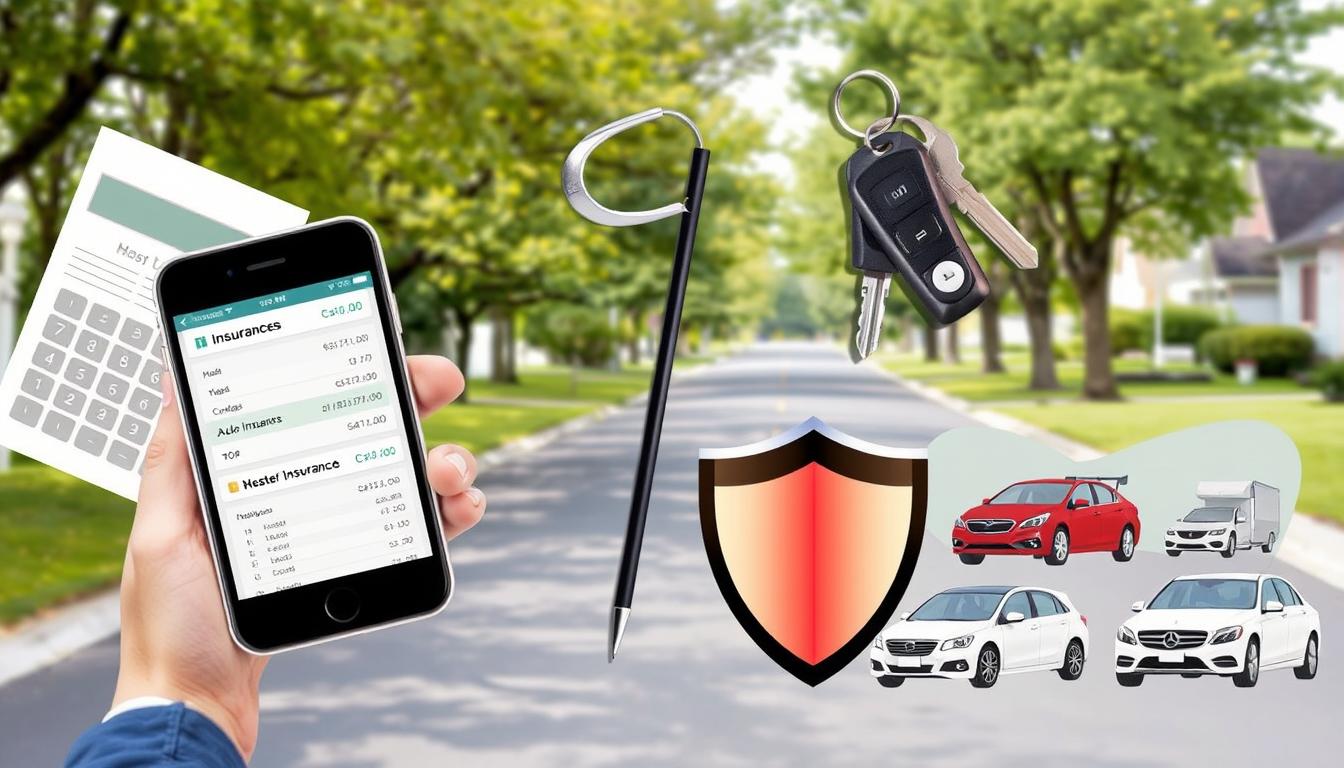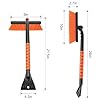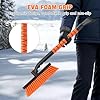Table of Contents
Looking for car insurance that fits your budget and needs? Shopping around is key, says the National Association of Insurance Commissioners. To start, learn how to compare auto insurance quotes. This will help you find the best coverage for your money. Check out compare auto insurance quotes for more info.
Key Takeaways
- Shopping around for auto insurance can help you find the best coverage at an affordable rate.
- Comparing auto insurance quotes is the best way to save on car insurance.
- Requesting quotes from multiple insurers can help find the best fit for coverage needs and budget.
- Discounts are available for different categories of individuals, such as military members, federal employees, homeowners, and students.
- Understanding how to shop for auto insurance and finding the best auto insurance coverage can save you money and provide peace of mind.
- Evaluating insurance typically takes 15 to 30 minutes, and shopping around before policy renewals can help you get the best rate.
- Almost every state requires some type of liability coverage for drivers, and different states have different minimum coverage requirements.
Understanding the Basics of Auto Insurance Shopping
Auto insurance shopping can seem tough, but knowing the basics helps. You need to understand the types of coverage, key insurance terms, and state rules. With the right info, you can choose wisely.
In the U.S., auto insurance is a must. Each state has its own rules. The California Department of Insurance explains the coverage types, like liability, comprehensive, and collision. Knowing these is key to making a good choice.
Types of Coverage Available
There are several coverage types:
- Liability coverage: covers damages to others in an accident
- Comprehensive coverage: covers damages to your vehicle not related to an accident
- Collision coverage: covers damages to your vehicle in an accident
Essential Insurance Terms to Know
Knowing insurance terms is crucial. Terms like premium, deductible, and coverage limit are important. They help you understand the process better.
State Minimum Requirements
Every state has its own auto insurance rules. These rules change, so check your state’s department of insurance. State rules usually include liability coverage and sometimes personal injury protection.
By learning about auto insurance basics, you can choose the right policy. This includes understanding coverage types, insurance terms, and state rules.
| Type of Coverage | Description |
|---|---|
| Liability Coverage | Covers damages to others in an accident |
| Comprehensive Coverage | Covers damages to your vehicle not related to an accident |
| Collision Coverage | Covers damages to your vehicle in an accident |
Gathering Required Information Before Shopping
Shopping for insurance is easier when you have the right information. Consumer Reports says knowing your driving history, vehicle details, and coverage needs is key. This info helps you compare quotes and find the best insurance for you.
You’ll need your personal details like name, address, and driver’s license number. Also, know your vehicle’s make, model, and year. Your driving and insurance history, including any accidents or claims, are also important. With this info, you can start comparing insurance quotes.
Getting the right information makes shopping for insurance less overwhelming. It helps you get the best auto insurance rate. Online tools can also help you compare quotes and find the best deal. Whether you need basic or comprehensive coverage, having the right info makes it easier.
Shopping for insurance lets you compare rates and options from different providers. It can also help you save money on premiums. By gathering the necessary information and shopping around, you can find great auto insurance quotes. So, start shopping for insurance today and explore your options.
How to Shop for Auto Insurance: A Step-by-Step Approach
Shopping for auto insurance can seem overwhelming, but it doesn’t have to be. The National Association of Insurance Commissioners offers a tool to help you find the right coverage. It’s important to explore online shopping, work with insurance agents, and use comparison tools to get the best rates.
Remember to get car insurance quotes at least once a year. Rates can change often. Be honest about any tickets or accidents to get a more accurate quote. Some insurers, like Progressive, offer discounts for young drivers and students with good grades. You can find more information on online resources about warranties for pre-owned vehicles.
- Research and compare rates from different insurers
- Check for discounts, such as those offered for good grades or safe driving
- Use comparison tools to find the best rates
- Work with insurance agents to get personalized advice
In 2020, the medical costs from fatal motor vehicle accidents were over $537 million. This shows how crucial it is to have enough coverage. By following these steps and using online shopping methods, you can find the right auto insurance for your budget and needs.
| Insurer | Discounts | Comparison Tools |
|---|---|---|
| Progressive | Good grades, safe driving | Snapshot® program |
| Other Insurers | Varying discounts | Online comparison tools |
The Importance of Shopping Around for Coverage
When looking for car insurance, shopping around is key. It helps you find the best coverage options at affordable rates. The California Department of Insurance says comparing rates can lead to better deals.
Some people check their car insurance rates every year. This is usually when their policy is up for renewal. They do this to make sure they’re getting the best deal for their coverage options. Switching insurers can save you a lot of money, especially since car insurance can cost over $2,000 a year.
Things like changes in your life, your credit score, and adding teen drivers can affect your rates. Affordable rates are out there, and shopping around can help you find them. Also, some companies offer discounts for having multiple policies, making it even more important to shop around.
In short, shopping around for car insurance is crucial. It lets you find the best coverage options at affordable rates. By comparing rates and using discounts, you can save money and get the right coverage for you.
| Insurance Company | Average Annual Cost |
|---|---|
| State Farm | $1,800 |
| Geico | $1,600 |
| Nationwide | $1,700 |
Comparing Major Insurance Providers
When looking for auto insurance, it’s key to compare rates and coverage from different providers. Consumer Reports says comparing major insurers can lead to the best coverage at a good price. Companies like GEICO, Progressive, State Farm, and Allstate offer various options and discounts.
Studies show car insurance rates can differ by over $1,000 a year between companies. For example, a 35-year-old with a clean record might pay $2,296 annually for full coverage. But rates can jump after incidents like a DUI or accident.
Key Factors in Insurance Rates
Many things affect insurance rates, like driving history, credit score, and age. A 35-year-old with poor credit might pay $3,774 yearly for full coverage, versus $2,296 for good credit. A 20-year-old might face an average annual rate of $4,712, while a 70-year-old’s rate could be $2,126.
- GEICO offers coverage and services in all 50 states and the District of Columbia, with 16 different types of discounts available.
- State Farm is one of the largest auto insurers in the U.S. based on market share.
- Allstate provides a range of coverage options and discounts, including discounts for good students and multi-policy holders.
By comparing quotes from various providers, you can find the best rate for you. It’s important to look at coverage options, discounts, and customer service when choosing an insurance provider.
Factors That Influence Your Insurance Rates
When you look for auto insurance, knowing what affects your rates is key. The National Association of Insurance Commissioners says your driving history, vehicle type, and coverage choices matter a lot. For example, adding safety features to your car might lower your insurance costs.
Some cars cost more to insure than others. This is because of things like how often they get into accidents, how much they cost to fix, and their safety features. Cars with better safety ratings and fewer claims are usually cheaper to insure.
Also, the make, model, year, and trim of your car affect your insurance rates, especially for collision and comprehensive coverage. Safety features can help lower your rates, especially if your car has the latest tech. Knowing these details can help you choose better insurance and save money.
Some important things that affect your insurance rates include:
- Driving history
- Vehicle type
- Coverage options
- Safety features
- Make, model, year, and trim level of the car
By thinking about these factors and looking at different coverage options, you can find the best insurance rates for your budget.
Understanding How Credit Scores Impact Insurance Premiums
Credit scores are key in setting insurance rates. Experian says most states let insurers use credit scores to set rates. This means people with bad credit pay more for insurance.
Drivers with poor credit might pay up to 88% more for auto insurance. This is because insurance companies use credit scores to guess who might make claims. Scores range from excellent to poor, affecting rates.
Nationwide explains how credit scores change car insurance rates. To lower your rates, keep your credit good by paying bills on time and using less than 30% of your credit limit.
Using services like Experian Boost can also help. It adds regular payments to your credit report. Knowing how credit scores affect insurance can help you save money.
- Pay your bills on time
- Keep credit utilization rates below 30%
- Monitor your credit report for errors
- Consider using credit-boosting services
Follow these tips to manage your credit and lower your insurance rates. Understanding credit scores’ impact is the first step.
Age-Related Insurance Considerations
Age is a big factor in car insurance rates. Younger drivers often pay more because they have less driving experience. Rates usually drop a lot at 25, by about 9%.
Drivers between 50 and 60 years old usually get the best rates. But, those 70 to 80 years old might see rates go up. This is because they might be at higher risk for accidents and medical costs. Seniors can take driving courses to get discounts or bundle auto and home insurance for savings.
Here are some average annual full coverage car insurance rates by age:
- 18 years: $5,242
- 25 years: $2,010
- 35 years: $1,730
- 45 years: $1,647
- 55 years: $1,528
- 65 years: $1,555
- 75 years: $1,817
It’s key to think about these insurance considerations and look at coverage options to get the best rates. Knowing how age affects rates can help you save on premiums.
| Age Group | Average Annual Rate |
|---|---|
| 18-24 | $5,242 |
| 25-34 | $2,010 |
| 35-44 | $1,730 |
| 45-54 | $1,647 |
| 55-64 | $1,528 |
| 65-74 | $1,555 |
| 75 and older | $1,817 |
Strategies for Finding the Cheapest Insurance Rates
Car insurance costs have gone up by 21% in 2024, says the Bureau of Labor Statistics. Finding cheap insurance rates is now a top priority for many. You can save money by using discounts, like those for bundling policies or safe driver programs.
Some companies give discounts for taking a defensive driving course. This is great for senior drivers over 65. Also, choosing higher deductibles on comprehensive and collision coverage can help save money. Insurance agent Earl Jones says raising your deductible to $1,000 can cut your insurance by 10% to 15%.
Telematics programs, like Allstate’s Drivewise or Progressive’s Snapshot, offer big discounts for safe drivers. Alaina Hixson, from the Churchill Agency, says these programs can save up to 30% on insurance. By looking into these options and comparing quotes, you can find the cheapest rates that fit your needs.
Here are some key strategies for finding the cheapest insurance rates:
- Take advantage of available discounts, such as bundling policies or participating in safe driver programs
- Opt for higher deductibles on comprehensive and collision coverage
- Consider telematics programs, such as Allstate’s Drivewise or Progressive’s Snapshot
- Compare auto insurance quotes from multiple providers to find the best rates
By using these strategies and looking at all your options, you can find the cheapest insurance rates. This will help you save money on your car insurance.
| Insurance Company | Discounts Offered | Average Savings |
|---|---|---|
| Allstate | Bundling policies, safe driver programs | 10-15% |
| Progressive | Telematics programs, defensive driving courses | 15-30% |
| State Farm | Good student discounts, multi-vehicle discounts | 5-10% |
Evaluating Insurance Provider Reliability
When looking for auto insurance, checking the provider’s reliability is key. You should look at their customer service, claims handling, and financial health. The National Association of Insurance Commissioners says this is vital. A reliable provider gives you peace of mind and protects you in accidents.
Customer service is a big part of reliability. Look for providers that are available 24/7 and are known for quick claims handling. Check online reviews and ratings from J.D. Power to see how good they are. Also, check if the provider is financially stable. A rating of A or higher from A.M. Best means they can pay claims well.

Companies like State Farm and Geico offer discounts and good rates. But, compare quotes from different providers to find the best deal. Use tools like Bankrate to compare and research. By looking into reliability and doing your homework, you can pick a provider that fits your needs and budget.
Things like age, where you live, and how you drive affect your rates. Good credit can lower your insurance costs, while bad credit can raise them. Knowing this and checking provider reliability helps you choose the right insurance for you.
Understanding Monthly Premium Costs
When looking for auto insurance, it’s key to know what affects monthly premium costs. A good rate changes based on the driver, vehicle, and where you live. The California Department of Insurance says it’s important to understand monthly premium costs when you’re shopping.
Is $100 a month for car insurance a good rate? It depends on your age, driving history, and where you live. For example, city drivers often pay more because of more thefts and accidents. This can change regional price variations.
Here are some things that can change monthly premium costs:
- Driver’s profile: Age, driving history, and credit score
- Vehicle: Make, model, and year of the car
- Location: Urban or rural area, state, and zip code
- Coverage: Type and amount of coverage, including policy limits and deductibles
Knowing these factors helps you understand monthly premium costs better. You can find a good rate that fits your needs. By looking at regional price variations and other factors, you can make a smart choice when buying auto insurance.
| State | Average Annual Rate |
|---|---|
| Wyoming | $1,108 |
| Louisiana | $4,000 |
The Role of Location in Insurance Rates
Location is a big deal when it comes to car insurance. Things like local crime rates and weather can change how much you pay. The National Association of Insurance Commissioners says areas with more crime cost more to insure.
Where you live can also change your insurance rates. For example, city drivers might pay more than those in the country. This is because cities have more accidents and theft. To find out more, check out insurance news sites.
Some things that can change your insurance rates based on where you live include:
- Crime rates
- Weather conditions
- Population density
- Road conditions
Knowing how location affects insurance rates can help you choose better. By looking at regional factors and comparing insurance, you can get the best deal for you.
Making the Most of Insurance Quotes
When looking for car insurance, it’s key to use insurance quotes wisely. Consumer Reports says reading and comparing quotes can help you find the right policy. Start by figuring out what insurance you need. You’ll need to give out some personal info to get quotes, like your current coverage and car details.
It’s smart to compare quotes from at least three companies. This way, you can see how different policies stack up. Companies often give discounts for things like bundling policies or being a safe driver. Make sure the quotes you compare have the same coverage and limits.
You can check out insurance company websites to learn about their options and discounts.
Reading Quote Details
It’s important to understand what your policy includes. Look at what affects your insurance rates, like your car and driving history. Personal details like your zip code and driving record are also important.
Comparing Coverage Options
When comparing policies, think about the company’s service and reputation. Look for discounts that can lower your rates. By carefully looking at your options, you can find a policy that fits your budget and needs.
Don’t forget to check and update your insurance regularly. Shopping around can help you find better deals and coverage. By following these tips, you can get the most out of insurance quotes and find the best policy for you.
Common Shopping Mistakes to Avoid
Shopping for insurance can lead to mistakes that cost you more or leave you uncovered. Not comparing quotes from different providers is a big error. It can mean missing out on better rates or more complete coverage. The National Association of Insurance Commissioners warns about not reading policy details and not asking questions. These mistakes can lead to unexpected costs or claims that aren’t covered.
Some common pitfalls to watch out for include:
- Choosing a policy just because it’s cheap, leading to extra costs and stress when you need to make a claim
- Not looking at other important factors like the quality of coverage, the reputation of the insurer, and their customer service
- Not carefully checking policy details to understand what’s covered, what’s not, and any costs like cancellation fees
Knowing these common mistakes can help you avoid them. Take your time to look over insurance options carefully. This way, you can make sure you have the right coverage for your needs and budget.
| Common Shopping Mistakes | Consequences |
|---|---|
| Not comparing quotes | Missing out on better rates or more comprehensive coverage |
| Not reading policy details | Unexpected costs or uncovered claims |
| Not asking questions | Lack of understanding of coverage limits, exclusions, and deductibles |
When to Review and Update Your Coverage
It’s important to check your auto insurance often. Insurance changes can happen because of big life events. For example, getting married, moving, or having a teen driver. You should review coverage to make sure you’re not under or overinsured.
Buying a new car, retiring, or changing jobs are other times to update coverage. If you drive less or have a clean record, you might get lower rates. The California Department of Insurance says to check your coverage after big life changes.
Here are some times when you might need to review and update your coverage:
- Moving to a new area with different insurance costs
- Getting married and combining policies
- Having a teenage driver added to your policy
- Retiring and driving less
- Purchasing a new car
Insurance changes can happen anytime. It’s key to know about any updates that might change your coverage. By regularly checking and updating, you can make sure you’re protected right and might save on premiums.
Always review coverage and adjust as needed. This might mean update coverage for new jobs or changes in driving habits. Keeping your insurance up to date gives you peace of mind and helps avoid financial losses.
| Life Event | Potential Insurance Impact |
|---|---|
| Moving to a new area | Changes in insurance costs |
| Getting married | Potential discounts for combined policies |
| Having a teenage driver | Increased premiums |
Conclusion: Making an Informed Insurance Decision
Shopping for auto insurance requires careful thought. You should look at your coverage options and compare rates from different providers. Also, check the reliability and reputation of the company to make the best choice for you.
Auto insurance isn’t the same for everyone. Some might need comprehensive and collision coverage, while others might be okay with liability-only policies. It’s important to know your state’s minimum requirements and think about your risk level. Also, look for discounts and bundle deals to save money.
When you’re looking for auto insurance, focus on finding a reliable provider. Look for one that offers good coverage and customer service. By making a smart choice, you can drive with peace of mind, knowing you’re protected.





























































